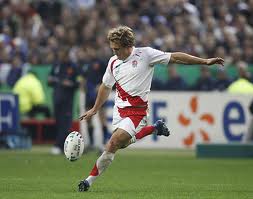 This month I am going to take a look at kicking in rugby, which is a very important rugby skill that can have a huge impact on a match. A team which has no kickers not only miss out on the opportunity to gain valuable points, but are at a disadvantage throughout the whole of a match. Again, this is a basic introduction and over the next few blogs the rules will get more complex.
This month I am going to take a look at kicking in rugby, which is a very important rugby skill that can have a huge impact on a match. A team which has no kickers not only miss out on the opportunity to gain valuable points, but are at a disadvantage throughout the whole of a match. Again, this is a basic introduction and over the next few blogs the rules will get more complex.
Many teams have players who can kick the ball but every team has one or two players who are more consistent kickers and hence they become regarded as some of the most valuable players of the squad.
One of the things that makes good kickers is the ability to kick accurately under tremendous pressure. The RFU has published a good document on how to increase your kicking effectiveness under pressure. Check it out here.
If a team have a reliable kicker, they do not have to rely on scrums and can have the kicker put a kick in the corner to put the opposing team under real pressure or they can have the kicker convert a penalty and put more points on the board, thereby rewarding the rest of the team who have worked hard to force the error from the opposing team in the first place.
There are different kinds of kicks – some gain a team points some gain a team an advantage in terms of yardage.
Kick-Off
For a kick-off the main rule is that the ball must go forward at least 10 metres. The kicker has three options when kicking:
- Long kick to try and put the opposing team under pressure;
- Short kick to try and get a teammate to take the ball and possession; or
- Kick to the opposing team’s 22, which puts pressure on the opposing player to try and kick the ball away.
Please see below for more information about drop kicking.
Penalty Kicking
Penalties will happen in every game of rugby and if a team have a kicker who converts the majority of these, it takes the pressure off the rest of the team to score tries due to the fact that it is possible for a team to win a game through penalties only. Penalty kicks are generally awarded for offside and foul play.
This is an example of a penalty by Dan Carter, a player well-known for his good kicking ability:
Goal Kicking
Like penalties, conversions are a very important aspect of the rugby game and a good goal kicker can make a big difference in a match. Place kicking is one of the hardest skills to perfect, but with constant practice and dedication it can turn into a player’s most valuable skills.
A consistent goal kicker is able to contribute to points, demotivate the opposition, make the opposition more careful at the ruck (giving the other team the advantage) and provide energy to his team when rewarding the team’s efforts with points.
Practicing this skill is vital and we have found this site to have some very good place kicking tips.
Drop Kicking
The Drop Kick is the only way you can score points in a match without the opposition making any mistakes. The Drop Kick is used for restarts and for drop goals.
Drop goals are always seen as a dramatic end to a match, and in most cases they are. A converted or missed drop goal impacts heavily on the match.
Below is an example of a crucial drop goal which was converted by Ronan O’Gara to give Ireland the win in the Grand Slam and the Triple Crown. O’Gara is considered by some as one of the best kickers in the 21st century to date.
Drop goals can also be converted if a team feels that they may not get a try and have no chance of moving nearer to the try line.
You can find good tips for practicing drop kicks here.
Possession Kicking
This is the trickiest type of kicking because if a kicker gets it wrong they can give away not only possession but also the advantage the rest of the team has worked so hard to gain. Possession kicking includes kicking the ball forward to put opposition under pressure and hoping they drop the ball near their try line or kicking to a teammate which results in the opposing team not being able to tackle the teammate before the try.
If the ball goes behind the 22 and is kicked out on the full from there, the lineout is taken from where the ball was kicked. But, if the kick bounces into touch, the lineout is taken from where the ball went into touch.
Click here for a good article to master different kinds of rugby kicks.
We also found the following site to be excellent in providing specific tips on how to practice the following types of kicks:
Conclusion
Every rugby player, be it forward or back, can benefit from having a good kicking ability, so don’t think that kicking skill is reserved for the flyhalf and fullback only. The better a team can kick and the more players they have with this ability, the more effective they can be in gaining a tactical advantage over their opponents.
So, what are you waiting for? Get out there and practice!
By: Tom Feaheny
Twitter: @ThomasFeaheny








 When most people hear the word “Peloton” they think of an expensive black bike with shiny red buttons and that controversial commercial where the husband gifted his wife a Peloton for Christmas.
When most people hear the word “Peloton” they think of an expensive black bike with shiny red buttons and that controversial commercial where the husband gifted his wife a Peloton for Christmas. If the app interests you, Peloton is currently offering a 30 day FREE TRIAL, so why not give it a try? Check it out
If the app interests you, Peloton is currently offering a 30 day FREE TRIAL, so why not give it a try? Check it out 

 This article would not be complete, however, if we did not acknowledge some of the delivery issues that have been plaguing Peloton over the last year. Most of the delivery issues seem to affect U.S. deliveries, however, the UK deliveries have been affected as well.
This article would not be complete, however, if we did not acknowledge some of the delivery issues that have been plaguing Peloton over the last year. Most of the delivery issues seem to affect U.S. deliveries, however, the UK deliveries have been affected as well.







